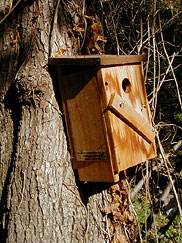Reed Canyon Enhancement Strategy
Native Plant Revegetation
When the management of invasive vegetation in a given area is under control, enhancement by addition of native plant materials can begin. Where proposed, habitat creation in the form of snags and downed large woody debris should be created / imported prior to planting so that access to the site is clear. The following is a list of enhancement elements to be considered, followed by specific plant community lists for revegetation of Reed Canyon.
Soil Preparation - Habitat Creation - Native Plantings - Plant Communities
 Soil Preparation
Soil Preparation
Soil preparation will be based on what is found following the removal of invasive species. Some areas may require minor soil amendments, but it is likely only in limited circumstances.
Recommended Management Strategy:
- Upon completion of invasive species removal determine the levels of soil amendments needed, if any.
- Use only weed-free soil additives such as mature leaf compost, to reduce further invasive species contamination of the site.
- Use gypsum if dense soils need to be amended for better drainage of water.

Habitat Creation
Creating additional habitat at the site will require the import or movement of large woody debris. Habitat features should be added once invasive species are under control and before native planting are added.
Recommended Management Strategy:
- Maintain standing and downed woody debris on site for cavity nesters and as basking logs for turtles.
- Add bat and bird boxes throughout the site, on the edge of transition habitat areas.
- Import additional large woody debris if available and as needed.

Native Plantings
Planting of the different management zones will occur as areas are cleared of invasive species and appropriately prepared. Successful revegetation of the site will require proper propagation, installation, maintenance and monitoring of the existing and newly installed plant material.
Recommended Management Strategy:
- Planting is best during the late fall, winter, and early spring. Seed during the late summer/early fall or early spring.
- Heal-in plant material to site for several weeks prior to planting by placing it in the area in which it will be planted; propagate plant material on-site if there is interest in doing so.
- Provide topsoil mix in planting hole if soil conditions are poor; topdress all plantings with mature leaf compost to provide nutrients and protect from dry out (particularly in sunny locations).
- If beavers are an issue, surround plants with welded wire guards to keep them from damaging new plantings or larger existing trees.
- Provide erosion control as needed by seeding ground with sterile wheat or re-green or the native seed recommended. Some areas may require soil bioengineering techniques.
- Deep water plant material 5-8 times per summer for the first two to three years, or longer if needed.
- Weed around new plantings at least twice a year, and place additional mature leaf compost.
Plant Communities
The following is a list of suggested plants by their community type. Detailed information on the placement of these plants as part of the revegetation strategy is provided in the Implementation Strategy Section.
To see photos, habitat requirements, and taxonomic information for the plants listed below, please visit the CalFlora database.
Forested Wetland Zones
Oregon Ash (Fraxinus latifolia)
Pacific Ninebark (Physocarpus capitatus)
Red-osier dogwood (Cornus stolonifera)
Snowberry (Symphoricarpus albus)
Slough sedge (Carex obnupta)
Corn lily (Ceratrum californicum)
Spreading or grooved rush (Juncus patens)
Dewey's sedge (Carex deweyana)
Small fruited bulrush (Scirpus microcarpus)
Tall mannagrass (Glyceria elata)
Riparian Edge Zones
Scouler willow (Salix scouleriana)
Pacific willow (Salix lasiandra)
Sitka willow (Salix sitchensis)
Red-osier dogwood (Cornus stoloniferia)
Clustered rose (Rosa pisocarpa)
Douglas spirea (Spirea douglasii)
Nodding beggartick (Bidens cernua)
Small flowered forget-me-not (Myosotis laxa)
Marsh Zones
Sawbeaked sedge (Carex stipata)
Creeping spike rush (Eleocharis palustris)
American brooklime (Veronica americana)
Beaked sedge (Carex utriculata)
Simple stem bur-reed (Sparganium emersum)
Hardstem bulrush (Scirpus accutus)
Small frited bulrush (Scirpus microcarpus)
Pointed rush (Juncus oxymeris)
Northern mannagrass (Glyceria borealis)
Open Water / Aquatic Zones
Wapato (Sagittaria latifolia)
American water plantain (Alisma plantago-aquatica)
Watershield (Brasenia schreberi)
Water smartweed (Polygonum amphibium)
Yellow pond lily (Nuphar lutea ssp polysepala)
Marsh cinquefoil (Potentilla palustris)
Headwater Riparian Forest Zone
Red alder (Alnus rubra)
Western Red Cedar (Thuja plicata)
Western hemlock (Tsuga heterophylla)
Big leaf maple (Acer macrophyllum)
Douglas Fir (Pseudotsuga menziesii)
Cascara (Rhamnus purshiana)
Pacific dogwood (Cornus nattallii)
Vine Maple (Acer circinatum)
Red elderberry (Sambucus racemosa)
Red-osier dogwood (Cornus stoniferia)
Indian plum (Oemleris cerasiformis)
Baldhip rose (Rosa gymnocarpa)
Snowberry (Symphoricarpos albus)
Salmonberry (Rubus spectabilis)
Sword fern (Polystichum munitum)
Cascade Oregon Grape (Mahonia nervosa)
Tall Oregon Grape (Mahonia aquifolium)
Salal (Gaultheria shallon)
Thimbleberry (Rubus pariflorus)
Woods Rose (Rosa woodsii)
Serviceberry (Almelanchier alnifolia)
Wood strawberry (Fragaria vesca)
Blue Wildrye (Elymus glaucus)
Skunk cabbage (Lysichitum americanum)
Idaho or Oregon bentgrass (Agrostis idahensis or oregonensis)